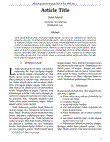Resultados de búsqueda - "North America"
Materias dentro de su búsqueda.
Materias dentro de su búsqueda.
- Acero 1
- América Septentrional 1
- América del Norte 1
- Autonomy; indigenous liberation; self-government; North America; native organizations 1
- Autonomía; liberación indígena; autogobierno; Norteamérica; organizaciones nativas 1
- C65 1
- C67 1
- Chiroptera 1
- Customs 1
- Economics Networks 1
- Graph Theory 1
- Input –output model 1
- Latin America 1
- Latinoamérica 1
- Leyes de Townshend; Ley del Té; impuestos; rebelión; identidad nacional 1
- Modelo de Insumo-Producto 1
- Monarquía Hispánica 1
- Nación pisona 1
- North America 1
- O51 1
- O54 1
- Pisones 1
- Pseudogymnoascus destructans 1
- R15 1
- Redes económicas 1
- Teoría de gráficas 1
- Townshend's Laws; Tea Law; taxes; rebellion; National identity 1
- Tradescantia spathacea 1
- aduana 1
- communication policies 1
-
1
-
2
-
3
Autogobierno indígena en Norteamérica
Publicado 2022Materias: “…Autonomy; indigenous liberation; self-government; North America; native organizations.…”
Enlace del recurso
Artículo -
4
Una red económica norteamericana: A North American economic network
Publicado 2016Materias: “…North America…”
Enlace del recurso
Artículo -
5
La última cristiandad: La nación pisona y la órbita hispánica en la América Septentrional durante los siglos XVII-XVIII
Publicado 2022“…The Last Christianity: The Pisona Nation and the Hispanic Orbit in North America during the 17th-18th Centuries…”
Enlace del recurso
Artículo -
6
Patrones de distribución, biología e identificación de cinco especies exóticas de milpiés planos (diplopoda: polydesmida: paradoxosomatidae) presentes en Norteamérica
Publicado 2019“…Koch, 1847) (Diplopoda: Polydesmida: Paradoxosomatidae) is established in North America using the niche modelling analysis software Maxent. …”
Enlace del recurso
Tesis -
7
Patrones de distribución, biología e identificación de cinco especies exóticas de milpiés planos (diplopoda: polydesmida: paradoxosomatidae) presentes en Norteamérica
Publicado 2019“…Koch, 1847) (Diplopoda: Polydesmida: Paradoxosomatidae) is established in North America using the niche modelling analysis software Maxent. …”
Enlace del recurso
Tesis -
8
Latin America: the next region for haematopoietic transplant progress
Publicado 2017“…This rate is substantially lower than that in North America and European regions (482 and 378) but higher than that in the Eastern Mediterranean and Asia Pacific regions (30 and 45). …”
Enlace del recurso
Artículo -
9
Clinical characterization of acute and convalescent illness of confirmed chikungunya cases from Chiapas, S. Mexico: A cross sectional study
Publicado 2017“…Background The emerging chikungunya virus (CHIKV), is an arbovirus causing intense outbreaks in North America. The situation in Mexico is alarming, and CHIKV threatens to spread further throughout North America. …”
Enlace del recurso
Artículo -
10
Clinical characterization of acute and convalescent illness of confirmed chikungunya cases from Chiapas, S. Mexico: A cross sectional study
Publicado 2017“…Abstract Background The emerging chikungunya virus (CHIKV), is an arbovirus causing intense outbreaks in North America. The situation in Mexico is alarming, and CHIKV threatens to spread further throughout North America. …”
Enlace del recurso
Artículo -
11
Prevalencia de hipersensibilidad al polen de Cupressus en pacientes alérgicos en Monterrey, México
Publicado 2010“…ABSTRACT Cupressus pollen is one of the main causes of allergic respiratory disease in North America. In a previous study of pollen concentration in Monterrey, Cupressus occupied the 3rd place in frequency.…”
Enlace del recurso
Artículo -
12
-
13
Complete Genome Sequence of Houston Virus, a Newly Discovered Mosquito-Specific Virus Isolated from Culex quinquefasciatus in Mexico
Publicado 2018“…The isolate was recovered from Culex quinquefasciatus in southern Mexico, which shows that the geographic range of Houston virus is not restricted to the United States in North America.…”
Enlace del recurso
Artículo -
14
Maturing Arc signatures monired by trace element and Hf isotope systematics in the early cretaceous Zacatecas volcanic field, Mexico
Publicado 2014“…Mesozoic growth of continental crust along the southwestern margin of North America and its southern extension in Mexico has been partly explained by the accretion of terranes. …”
Enlace del recurso
Artículo -
15
Freshwater fishes and water status in Mexico: A country-wide appraisal.
Publicado 2008“…Mexico is the southernmost country in North America, and extends into Central America, south of the Isthmus of Tehuantepec. …”
Enlace del recurso
Artículo -
16
Serologic evidence of west nile virus infection in birds, Tamaulipas State, México
Publicado 2003“…Following the introduction of West Nile virus (WNV) into North America in 1999, surveillance for WNV in migratory and resident birds was established in Tamaulipas State, northern México in December 2001. …”
Enlace del recurso
Artículo -
17
Dental iron precipitates in patients with Type 2 diabetes
Publicado 2018“…There are currently more than 46 million people who suffer this disease in North America and the Caribbean. The objective of this study was to determine if there is an association between DM and the presence of iron precipitates (Fe2+) in dental structure. …”
Enlace del recurso
Artículo -
18
Population density of the western burrowing owl (Athene cunicularia hypugaea) in Mexican prairie dog (Cynomys mexicanus) colonies in northeastern Mexico
Publicado 2016“…Background: The western burrowing owl (Athene cunicularia hypugaea) occurs throughout western North America in various habitats such as desert, short-grass prairie and shrub-steppe, among others, where the main threat for this species is habitat loss. …”
Enlace del recurso
Artículo -
19
Biochemical systematics and population genetic structure of Anopheles pseudpunctipennis, vector of malaria in central and South America.
Publicado 1995“…Geographic populations of An. pseudopunctipennis were classified into three clusters; one cluster included populations collected in North America (United States and Mexico) and Guatemala, one cluster included populations from Belize and South America (Colombia, Ecuador, Peru, Chile, and Argentina); and one cluster was represented by populations from the Island of Grenada (type-locality of An. pseudopunctipennis). …”
Enlace del recurso
Artículo -
20
Tradescantia spathacea y epigalocatequina; ciencia en la medicina ancestral
Publicado 2024Enlace del recurso
Artículo


